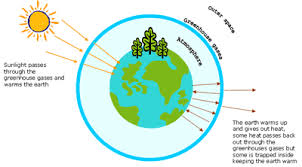Overview
The role of climate, the average weather conditions at a particular location and time, has a large effect on the plants and animals that live in a particular area. Some of the elements that affect climate include the greenhouse effect, latitude, ocean currents, prevailing winds, and landmasses.
Climate
Weather refers to day-to-day conditions, while climate refers to the average variations in temperature, precipitation, humidity, and other related conditions over a longer period of time. Climates are often categorized in one of 3 broad zones, tropical, temperate, and polar, although there are many different subtypes of climate. The climate of a region is affected by many factors, including the latitude, winds, ocean currents, the amount of precipitation an area receives, and the shape and elevation of the land. Generally, solar energy has a great deal to do with climate.
Figure 1: General climate zones.
The Greenhouse Effect
The atmosphere of the earth provides natural insulation to the biosphere. Temperatures on the earth are within a range so that life can exist. Heat energy is trapped by “greenhouse gases” such as carbon dioxide, methane, and water vapor. More energy from the sun can come into the atmosphere than can be reflected back, making the earth warmer than it would be if the atmosphere didn’t trap heat energy.
Figure 2: The greenhouse effect works by trapping more heat energy than it allows to escape.
Latitude
The earth is tilted on its axis, so the energy from the sun falls on different angles, depending on the distant from the equator, also called latitude. The most direct sunlight falls at the equator, and the regions that are between the Tropic of Cancer (23.5o N), the equator, and the Tropic of Capricorn (23.5o S) are tropical. The warm temperate zones are those closest to the tropics, and the cold temperate zones are those farther away. The polar zones are between 66.5o (the Arctic Circle) and 90o N and 66.5o S and 90o.
Prevailing Winds
The atmosphere of the earth is heated unequally at different latitudes as it spins, so that heated air at the equator rises while cooler air sinks as it nears the poles. These patterns create prevailing winds. Similar currents of warm water and cold water occur in the ocean, as cold water near the poles sinks, rises as it comes to warmer regions, and falls when it comes into colder regions. The prevailing winds and ocean currents do a great deal to warm or cool a region. Landmasses also interfere with the movement of winds and ocean currents. For example, clouds carrying water vapor drop their contents as they rise above mountains, so there is more rainfall on the west side and less rainfall on the east side, creating a “rain shadow.”
Figure 3: Prevailing winds interact with ocean currents and landmasses to affect climate.
Interested in biology tutoring services? Learn more about how we are assisting thousands of students each academic year.
SchoolTutoring Academy is the premier educational services company for K-12 and college students. We offer tutoring programs for students in K-12, AP classes, and college. To learn more about how we help parents and students in Granby, QC, Canada visit: Tutoring in Granby, QC, Canada




